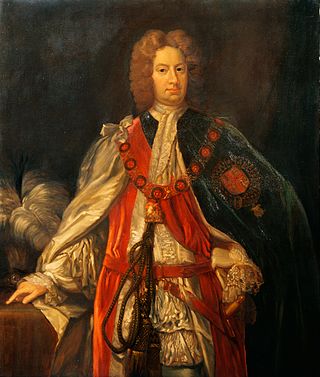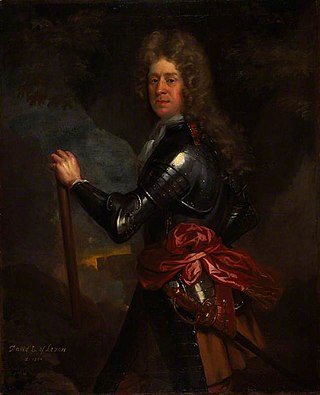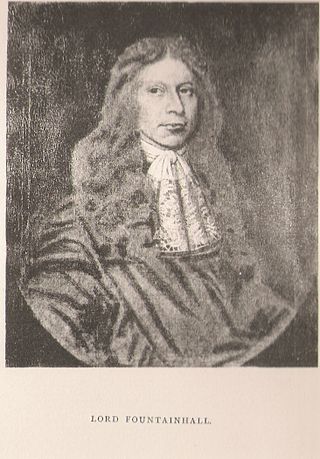
The Salem witch trials were a series of hearings and prosecutions of people accused of witchcraft in colonial Massachusetts between February 1692 and May 1693. More than 200 people were accused. Thirty people were found guilty, 19 of whom were executed by hanging as well as 2 dogs. One other man, Giles Corey, died under torture after refusing to enter a plea, and at least five people died in jail.

James Graham, 1st Duke and 4th Marquess of Montrose was a Scottish aristocratic statesman in the early eighteenth century.
The Privy Council of Scotland was a body that advised the Scottish monarch. In the range of its functions the council was often more important than the Estates in the running the country. Its registers include a wide range of material on the political, administrative, economic and social affairs of the Kingdom of Scotland. The council supervised the administration of the law, regulated trade and shipping, took emergency measures against the plague, granted licences to travel, administered oaths of allegiance, banished beggars and gypsies, dealt with witches, recusants, Covenanters and Jacobites and tackled the problem of lawlessness in the Highlands and the Borders.
Thomas Aikenhead was a Scottish student from Edinburgh, who was prosecuted and executed at the age of 20 on a charge of blasphemy under the Act against Blasphemy 1661 and Act against Blasphemy 1695. He was the last person in Great Britain to be executed for blasphemy. His execution occurred 85 years after the death of Edward Wightman (1612), the last person to be burned at the stake for heresy in England.

David Melville, later Leslie, 3rd Earl of Leven and de jure2nd Earl of Melville was a Scottish aristocrat, politician, and soldier.

Margaret Wilson was a young Scottish Covenanter from Wigtown in Scotland who was executed by drowning for refusing to swear an oath declaring James VII of Scotland as head of the church. She died along with Margaret McLachlan. The two Margarets were known as the Wigtown Martyrs. Wilson became the more famous of the two because of her youth. As a teenager, her faith unto death became celebrated as part of the martyrology of Presbyterian churches.

Sir John Lauder of Fountainhall, 2nd Baronet, Lord Fountainhall was one of Scotland's leading jurists who remains an oft-consulted authority. He was knighted in 1680 and matriculated his Arms with the Lyon Court on 15 June 1699.

Agnes Sampson was a Scottish healer and purported witch. Also known as the "Wise Wife of Keith", Sampson was involved in the North Berwick witch trials in the later part of the sixteenth century.

In early modern Scotland, in between the early 16th century and the mid-18th century, judicial proceedings concerned with the crimes of witchcraft took place as part of a series of witch trials in Early Modern Europe. In the late middle age there were a handful of prosecutions for harm done through witchcraft, but the passing of the Witchcraft Act 1563 made witchcraft, or consulting with witches, capital crimes. The first major issue of trials under the new act were the North Berwick witch trials, beginning in 1590, in which King James VI played a major part as "victim" and investigator. He became interested in witchcraft and published a defence of witch-hunting in the Daemonologie in 1597, but he appears to have become increasingly sceptical and eventually took steps to limit prosecutions.
Christian Shaw was a Scottish industrialist regarded as the founder of the thread industry in Renfrewshire. As a child, she was instrumental in the Bargarran witch trials of 1697.

The 1594 trial of alleged witch Allison Balfour or Margaret Balfour is one of the most frequently cited Scottish witchcraft cases. Balfour lived in the Orkney Islands of Scotland in the area of Stenness. At that time in Scotland, the Scottish Witchcraft Act 1563 had made a conviction for witchcraft punishable by death.

Witchcraft in Orkney possibly has its roots in the settlement of Norsemen on the archipelago from the eighth century onwards. Until the early modern period magical powers were accepted as part of the general lifestyle, but witch-hunts began on the mainland of Scotland in about 1550, and the Scottish Witchcraft Act of 1563 made witchcraft or consultation with witches a crime punishable by death. One of the first Orcadians tried and executed for witchcraft was Allison Balfour, in 1594. Balfour, her elderly husband and two young children, were subjected to severe torture for two days to elicit a confession from her.

The Pittenweem witches were five Scottish women accused of witchcraft in the small fishing village of Pittenweem in Fife on the east coast of Scotland in 1704. Another two women and a man were named as accomplices. Accusations made by a teenage boy, Patrick Morton, against a local woman, Beatrix Layng, led to the death in prison of Thomas Brown, and, in January 1705, the murder of Janet Cornfoot by a lynch mob in the village.
Marie Lamont, also referred to as Mary Lawmont (1646–1662), was executed for witchcraft during the reign of Charles II just after Witchmania had peaked in the United Kingdom. Her youth at the time of her execution made her case unusual.
Euphame MacCalzean was a victim of the North Berwick witch trials of 1590–1591.
Margaret Burges, also known as 'Lady Dalyell', was a Scottish businesswoman from Nether Cramond who was found guilty of witchcraft and executed in Edinburgh in 1629.
Sir Patrick Johnston (1650–1736) of Edinburgh was a Scottish merchant and politician who sat in the Parliament of Scotland from 1702 to 1707 and as a Whig in the British House of Commons between 1707 and 1713. He was Lord Provost of Edinburgh three times from 1700 to 1702, from 1704 to 1706, and from 1708 to 1710.
Sir Alexander Gordon of Earlston (1650–1726) was a 17th-century Scottish gentleman. He was known as a Covenanter and was member of the United Societies network. He was involved in the early 1680s in fomenting rebellion against the Crown in Scotland.
Bessie Wright was a healer in Perthshire who was accused of witchcraft in 1611, 1626 and then again in 1628.









